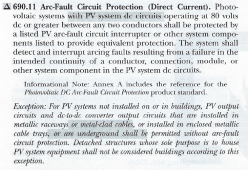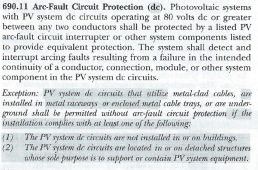FilterGuy
Solar Engineering Consultant - EG4 and Consumers
I was working on a design and came across an 'interesting'  change around PV arc fault protection in the 2023 NEC. In the 2020 code, you could have PV circuits going to your house without arc fault protection if the circuits were in metallic raceways (Conduits), In the 2023 code they seem to have removed that possibility.
change around PV arc fault protection in the 2023 NEC. In the 2020 code, you could have PV circuits going to your house without arc fault protection if the circuits were in metallic raceways (Conduits), In the 2023 code they seem to have removed that possibility.
This is one more thing that will make it difficult to do a code-compliant install with any of the value-priced inverters that do not have arc fault built in.
NEC 2020 Code 690.11

NEC 2023 Code 690.11

This is one more thing that will make it difficult to do a code-compliant install with any of the value-priced inverters that do not have arc fault built in.
NEC 2020 Code 690.11

NEC 2023 Code 690.11



